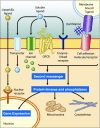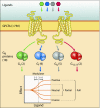Human aging and disease: Lessons from age-related macular degeneration
- PMID: 29483257
- PMCID: PMC5866596
- DOI: 10.1073/pnas.1721033115
Human aging and disease: Lessons from age-related macular degeneration
Abstract
Aging is the most significant risk factor associated with chronic disease in humans. The accumulation of genetic damage throughout life leads to a variety of biological aberrations, including disrupted protein homeostasis, metabolic dysfunction, and altered cellular signaling. Such changes ultimately result in cellular senescence, death, or transformation to uncontrolled proliferation, thereby compromising human health. Events contributing to age-dependent physiological decline also occur in the context of hormonal and metabolic changes, affecting interconnected cellular networks. This complexity often confounds the development of effective treatments for aging and age-related diseases. In contrast to monotherapy and polypharmacology, an innovative systems pharmacology approach can identify synergistic combinations of drugs that modulate distinct mechanistic nodes within a network, minimizing off-target side effects and enabling better therapeutic outcomes. G protein-coupled receptors (GPCRs) are particularly good targets for the application of systems pharmacology, because they activate different signal transduction pathways that can culminate in a common response. Here, we describe a systems pharmacology strategy for the treatment of age-related macular degeneration (AMD), a multifactorial chronic disease of the eye. By considering the retina as part of a large, interconnected network, systems pharmacology will enable the identification of combination therapies targeting GPCRs to help restore genomic, proteomic, and endocrine homeostasis. Such an approach can be advantageous in providing drug regimens for the treatment of AMD, while also having broader ramifications for ameliorating adverse effects of chronic, age-related disease in humans.
Keywords: GPCR; age-related macular degeneration; eye; photoreceptors; retina.
Conflict of interest statement
The authors declare no conflict of interest.
Figures






Similar articles
-
[Novel approach for management of age-related macular degeneration--antiangiogenic therapy and retinal regenerative therapy].Nippon Ganka Gakkai Zasshi. 2007 Mar;111(3):232-68; discussion 269. Nippon Ganka Gakkai Zasshi. 2007. PMID: 17402564 Review. Japanese.
-
Estrogen signalling in the pathogenesis of age-related macular degeneration.Curr Eye Res. 2015 Feb;40(2):226-33. doi: 10.3109/02713683.2014.925933. Epub 2014 Jun 9. Curr Eye Res. 2015. PMID: 24911983 Review.
-
Cone degeneration in aging and age-related macular degeneration.Arch Ophthalmol. 2009 Apr;127(4):483-92. doi: 10.1001/archophthalmol.2008.622. Arch Ophthalmol. 2009. PMID: 19365029
-
Age-related macular degeneration (AMD): Alzheimer's disease in the eye?J Alzheimers Dis. 2011;24(4):615-31. doi: 10.3233/JAD-2011-101908. J Alzheimers Dis. 2011. PMID: 21297256 Review.
-
Regulatory role of HIF-1alpha in the pathogenesis of age-related macular degeneration (AMD).Ageing Res Rev. 2009 Oct;8(4):349-58. doi: 10.1016/j.arr.2009.06.002. Epub 2009 Jul 7. Ageing Res Rev. 2009. PMID: 19589398 Review.
Cited by
-
Distinct mouse models of Stargardt disease display differences in pharmacological targeting of ceramides and inflammatory responses.Proc Natl Acad Sci U S A. 2023 Dec 12;120(50):e2314698120. doi: 10.1073/pnas.2314698120. Epub 2023 Dec 8. Proc Natl Acad Sci U S A. 2023. PMID: 38064509 Free PMC article.
-
Making Biological Sense of Genetic Studies of Age-Related Macular Degeneration.Adv Exp Med Biol. 2021;1256:201-219. doi: 10.1007/978-3-030-66014-7_8. Adv Exp Med Biol. 2021. PMID: 33848003
-
Age-related changes of individual macular retinal layers among Asians.Sci Rep. 2019 Dec 30;9(1):20352. doi: 10.1038/s41598-019-56996-6. Sci Rep. 2019. PMID: 31889143 Free PMC article.
-
Metabolic regulation of endothelial senescence.Front Cardiovasc Med. 2023 Aug 15;10:1232681. doi: 10.3389/fcvm.2023.1232681. eCollection 2023. Front Cardiovasc Med. 2023. PMID: 37649668 Free PMC article. Review.
-
Resilience to diabetic retinopathy.Prog Retin Eye Res. 2024 Jul;101:101271. doi: 10.1016/j.preteyeres.2024.101271. Epub 2024 May 11. Prog Retin Eye Res. 2024. PMID: 38740254 Free PMC article. Review.
References
-
- Johnell O, Kanis JA. An estimate of the worldwide prevalence and disability associated with osteoporotic fractures. Osteoporos Int. 2006;17:1726–1733. - PubMed
-
- US Department of Health and Human Services . National Diabetes Statistics Report, 2017. Centers for Disease Control and Prevention; Atlanta: 2017.
Publication types
MeSH terms
Grants and funding
LinkOut - more resources
Full Text Sources
Other Literature Sources
Medical

